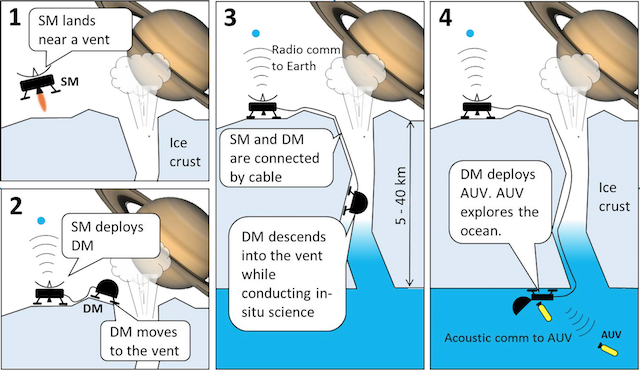NASA analyzes possible ways to explore the subglacial oceans of Europe and Enceladus

One of the photographs of the surface of Enceladus, the satellite of Saturn, sent by the Cassini probe
Many generations of reading lovers were fascinated by the ideas of one of the greatest science writers and popularizers of all time, Jules Verne. One of his novels, Journey to the Center of the Earth , describes a team of courageous researchers under the direction of Professor Otto Lidenbrock, who penetrated to the center of our planet. The starting point of the trip in this case was the Icelandic volcano Snaifelds. Through his mouth the journey began.
Of course, all this is fantastic, even fantasy, since modern scientists know that it is impossible to get to any center of the earth through any kind of volcano. But there is still a sensible idea here, although it cannot be realized in terrestrial conditions. Rational grain can be used in the case of traveling to the satellite of one of the giant planets of the Solar System. We are talking about Europe or Enceladus , which are covered with a layer of ice that hides a massive warm ocean of liquid water (many scientists believe that this is so). How to break through many kilometers of ice? The answer is already known: through the mouth of the volcano. Only not usual, but cryovolcano.
The idea sounds a bit fantastic, but for this we live to make the tale true. As part of the NASA Innovative Advanced Concepts Program (NIAC), the agency regularly assesses the realism of ideas that seem fantastic, but which can be implemented using existing technologies or technologies of the near future.
')
It is now known that the ice crust of Europe may be many kilometers long, and existing technologies do not allow remote access through the entire ice mass. But if you find a cryovolcano, it is possible that it will be possible to reach liquid water through its mouth .

This is how it may look (image: NASA / JPL-Caltech)
Of course, in this case we are talking about visiting one of these satellites by a group of automatic stations. Initially, the Icy-Moon Cryovolcano Explorer (ICE), a robotic station that lands a special probe for walking on the mouth of a cryovolcano, lands on a planetoid. This probe, going down the wall of the vent, gets to the water, where it drops another probe, this time the water one. And already this submarine begins to explore the subglacial ocean, sending information about its findings to the first probe, and he sends information to the station. The station also sends data to Earth.
Mountaineer probe, which will descend through the mouth, initially study the density of the substance emitted by the volcano. If scientists are convinced that it is still possible to descend, and the probe will not be damaged, the "climber" will begin its way down. In this case, the submarine signals are transmitted to the “mountaineer” using acoustic signals, and not radio waves. The first probe will also serve as a charging station for the robot submarine.
Now scientists are planning to explore the possible risks of the project. For this, the first phase was launched, during which researchers from JPL will receive $ 100,000 to work on the project within 9 months. If the mission is recognized as real, then the second phase will be launched, already with a fund in the amount of $ 500,000 and a work period of two years (research and development of devices).
Source: https://habr.com/ru/post/393303/
All Articles